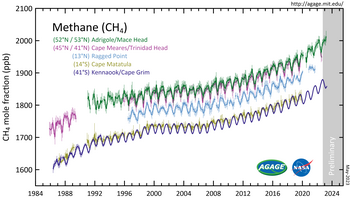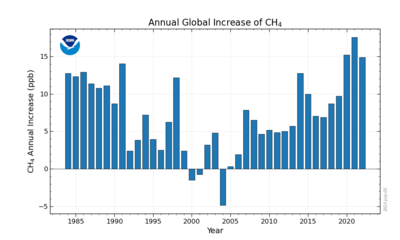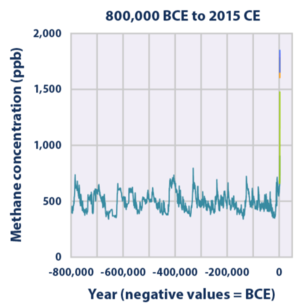Atmospheric methane is the methane present in Earth's atmosphere.[1] The concentration of atmospheric methane is increasing due to methane emissions, and is causing climate change.[2][3] Methane is one of the most potent greenhouse gases.[4]: 82 Methane's radiative forcing (RF) of climate is direct,[5]: 2 and it is the second largest contributor to human-caused climate forcing in the historical period.[5]: 2 Methane is a major source of water vapour in the stratosphere through oxidation;[6] and water vapour adds about 15% to methane's radiative forcing effect.[7] The global warming potential (GWP) for methane is about 84 in terms of its impact over a 20-year timeframe, and 28 in terms of its impact over a 100-year timeframe.[8][9]

Since the beginning of the Industrial Revolution (around 1750) the methane concentration in the atmosphere has increased by about 160%, and this increase is almost entirely caused by human activities.[10] Since 1750 methane has contributed 3% of greenhouse gas (GHG) emissions in terms of mass[11] but is responsible for approximately 23% of radiative or climate forcing.[12][13][14] By 2019, global methane concentrations had risen from 722 parts per billion (ppb) in pre-industrial times to 1866 ppb.[15] This is an increase by a factor of 2.6 and the highest value in at least 800,000 years.[16]: 4 [17][18]
Methane increases the amount of ozone (O3) in the troposphere (4 miles (6 km) to 12 miles (19 km) from the Earth's surface) and also in the stratosphere (from the troposphere to 31 miles (50 km) above the Earth's surface).[19] Both water vapour and ozone are GHGs, which in turn add to climate warming.[5]: 2
Role in climate change


Methane (CH4) in the Earth's atmosphere is a powerful greenhouse gas with a global warming potential (GWP) 84 times greater than CO2 over a 20-year time frame.[21][22] Methane is not as persistent as CO2, and tails off to about 28 times greater than CO2 over a 100-year time frame.[9]
Radiative or climate forcing is the scientific concept used to measure the human impact on the environment in watts per square meter (W/m2).[23] It refers to the "difference between solar irradiance absorbed by the Earth and energy radiated back to space"[24] The direct radiative greenhouse gas forcing effect of methane relative to the year 1750 was estimated at 0.5 W/m2 in the 2007 IPCC "Climate Change Synthesis Report 2007".[25]: 38
In their May 21, 2021 173-page "Global Methane Assessment", the UNEP and CCAP said that their "understanding of methane's effect on radiative forcing" improved with research by teams led by M. Etminan in 2016,[12] and William Collins in 2018,[5] which resulted in an "upward revision" since the 2014 IPCC Fifth Assessment Report (AR5). The "improved understanding" says that prior estimates of the "overall societal impact of methane emissions" were likely underestimated.[26]: 18
Etminan et al. published their new calculations for methane's radiative forcing (RF) in a 2016 Geophysical Research Letters journal article which incorporated the shortwave bands of CH4 in measuring forcing, not used in previous, simpler IPCC methods. Their new RF calculations which significantly revised those cited in earlier, successive IPCC reports for well mixed greenhouse gases (WMGHG) forcings by including the shortwave forcing component due to CH4, resulted in estimates that were approximately 20–25% higher.[12] Collins et al. said that CH4 mitigation that reduces atmospheric methane by the end of the century, could "make a substantial difference to the feasibility of achieving the Paris climate targets", and would provide us with more "allowable carbon emissions to 2100".[5]
In addition to the direct heating effect and the normal feedbacks, the methane breaks down to carbon dioxide and water. This water is often above the tropopause, where little water usually reaches. Ramanathan (1998)[27] notes that both water and ice clouds, when formed at cold lower stratospheric temperatures, are extremely efficient in enhancing the atmospheric greenhouse effect. He also notes that there is a distinct possibility that large increases in methane in future may lead to a surface warming that increases nonlinearly with the methane concentration.
Mitigation efforts to reduce short-lived climate pollutants like methane and black carbon would help combat "near-term climate change" and would support Sustainable Development Goals.[28]
Sources

Any process that results in the production of methane and its release into the atmosphere can be considered a "source". The known sources of methane are predominantly located near the Earth's surface.[11] Two main processes that are responsible for methane production include microorganisms anaerobically converting organic compounds into methane (methanogenesis), which are widespread in aquatic ecosystems, and ruminant animals. Other natural sources include melting permafrost, wetlands, plants, and methane clathrates.[citation needed]
Increasing methane emissions are a major contributor to the rising concentration of greenhouse gases in Earth's atmosphere, and are responsible for up to one-third of near-term global heating.[30][31] During 2019, about 60% (360 million tons) of methane released globally was from human activities, while natural sources contributed about 40% (230 million tons).[32][33] Reducing methane emissions by capturing and utilizing the gas can produce simultaneous environmental and economic benefits.[30][34]
Since the Industrial Revolution, concentrations of methane in the atmosphere have more than doubled, and about 20 percent of the warming the planet has experienced can be attributed to the gas.[35] About one-third (33%) of anthropogenic emissions are from gas release during the extraction and delivery of fossil fuels; mostly due to gas venting and gas leaks from both active fossil fuel infrastructure and orphan wells.[36] Russia is the world's top methane emitter from oil and gas.[37][38]
Animal agriculture is a similarly large source (30%); primarily because of enteric fermentation by ruminant livestock such as cattle and sheep. According to the Global Methane Assessment published in 2021, methane emissions from livestock (including cattle) are the largest sources of agricultural emissions worldwide[39] A single cow can make up to 99 kg of methane gas per year.[40] Ruminant livestock can produce 250 to 500 L of methane per day.[41]Measurement techniques
Methane was typically measured using gas chromatography. Gas chromatography is a type of chromatography used for separating or analyzing chemical compounds. It is less expensive in general, compared to more advanced methods, but it is more time and labor-intensive.[citation needed]
Spectroscopic methods were the preferred method for atmospheric gas measurements due to its sensitivity and precision. Also, spectroscopic methods are the only way of remotely sensing the atmospheric gases. Infrared spectroscopy covers a large spectrum of techniques, one of which detects gases based on absorption spectroscopy. There are various methods for spectroscopic methods, including Differential optical absorption spectroscopy, Laser-induced fluorescence, and Fourier Transform Infrared.[citation needed]
In 2011, cavity ring-down spectroscopy was the most widely used IR absorption technique of detecting methane. It is a form of laser absorption spectroscopy which determines the mole fraction to the order of parts per trillion.
Global monitoring

CH4 has been measured directly in the environment since the 1970s.[44][10] The Earth's atmospheric methane concentration has increased 160% since preindustrial levels in the mid-18th century.[10]
Long term atmospheric measurements of methane by NOAA show that the build up of methane nearly tripled since pre-industrial times since 1750.[45] In 1991 and 1998 there was a sudden growth rate of methane representing a doubling of growth rates in previous years.[45] The June 15, 1991 eruption of Mount Pinatubo, measuring VEI-6—was the second-largest terrestrial eruption of the 20th century.[46] In 2007 it was reported that unprecedented warm temperatures in 1998—the warmest year since surface records were recorded—could have induced elevated methane emissions, along with an increase in wetland and rice field emissions and the amount of biomass burning.[47]
Data from 2007 suggested methane concentrations were beginning to rise again.[48] This was confirmed in 2010 when a study showed methane levels were on the rise for the 3 years 2007 to 2009. After a decade of near-zero growth in methane levels, "globally averaged atmospheric methane increased by [approximately] 7 nmol/mol per year during 2007 and 2008. During the first half of 2009, globally averaged atmospheric CH4 was [approximately] 7 nmol/mol greater than it was in 2008, suggesting that the increase will continue in 2009."[49] From 2015 to 2019 sharp rises in levels of atmospheric methane have been recorded.[50]
In 2010, methane levels in the Arctic were measured at 1850 nmol/mol which is over twice as high as at any time in the last 400,000 years.[citation needed] According to the IPCC AR5, since 2011 concentrations continued to increase. After 2014, the increase accelerated and by 2017, it reached 1,850 (parts per billion) ppb.[51] The annual average for methane (CH4) was 1866 ppb in 2019 and scientists reported with "very high confidence" that concentrations of CH4 were higher than at any time in at least 800,000 years.[13] The largest annual increase occurred in 2021 with current concentrations reaching a record 260% of pre-industrial—with the overwhelming percentage caused by human activity.[10]
In 2013, IPCC scientists said with "very high confidence", that concentrations of atmospheric methane CH4 "exceeded the pre-industrial levels by about 150% which represented "levels unprecedented in at least the last 800,000 years."[13][52] The globally averaged concentration of methane in Earth's atmosphere increased by about 150% from 722 ± 25 ppb in 1750 to 1803.1 ± 0.6 ppb in 2011.[53][54] As of 2016, methane contributed radiative forcing of 0.62 ± 14% Wm−2,[12] or about 20% of the total radiative forcing from all of the long-lived and globally mixed greenhouse gases.[9] The atmospheric methane concentration has continued to increase since 2011 to an average global concentration of 1911.8 ± 0.6 ppb as of 2022.[15] The May 2021 peak was 1891.6 ppb, while the April 2022 peak was 1909.4 ppb, a 0.9% increase.[54]

The Global Carbon Project consortium produces the Global Methane Budget. Working with over fifty international research institutions and 100 stations globally, it updates the methane budget every few years.[55]
In 2013, the balance between sources and sinks of methane was not yet fully understood. Scientists were unable to explain why the atmospheric concentration of methane had temporarily ceased to increase.[56]
The focus on the role of methane in anthropogenic climate change has become more relevant since the mid-2010s.[57]
Natural sinks or removal of atmospheric methane
The amount of methane in the atmosphere is the result of a balance between the production of methane on the Earth's surface—its source—and the destruction or removal of methane, mainly in the atmosphere—its sink— in an atmospheric chemical process.[58]
Another major natural sink is through oxidation by methanotrophic or methane-consuming bacteria in Earth's soils.

These 2005 NASA computer model simulations—calculated based on data available at that time—illustrate how methane is destroyed as it rises.
As air rises in the tropics, methane is carried upwards through the troposphere—the lowest portion of Earth's atmosphere which is 4 miles (6.4 km) to 12 miles (19 km) from the Earth's surface, into the lower stratosphere—the ozone layer—and then the upper portion of the stratosphere.[58]
This atmospheric chemical process is the most effective methane sink, as it removes 90% of atmospheric methane.[56] This global destruction of atmospheric methane mainly occurs in the troposphere.[56]
Methane molecules react with hydroxyl radicals (OH)—the "major chemical scavenger in the troposphere" that "controls the atmospheric lifetime of most gases in the troposphere".[59] Through this CH4 oxidation process, atmospheric methane is destroyed and water vapor and carbon dioxide are produced.
While this decreases the concentration of methane in the atmosphere, it also increases radiative forcing because both water vapor and carbon dioxide are more powerful GHGs factors in terms of affecting the warming of Earth.
This additional water vapor in the stratosphere caused by CH4 oxidation, adds approximately 15% to methane's radiative forcing effect.[60][6]
By the 1980s, the global warming problem had been transformed by the inclusion of methane and other non-CO2 trace-gases—CFCs, N2O, and O3— on global warming, instead of focusing primarily on carbon dioxide.[61][62] Both water and ice clouds, when formed at cold lower stratospheric temperatures, have a significant impact by increasing the atmospheric greenhouse effect. Large increases in future methane could lead to a surface warming that increases nonlinearly with the methane concentration.[61][62]
Methane also affects the degradation of the ozone layer—the lowest layer of the stratosphere from about 15 to 35 kilometers (9 to 22 mi) above Earth, just above the troposphere.[63] NASA researchers in 2001, had said that this process was enhanced by global warming, because warmer air holds more water vapor than colder air, so the amount of water vapor in the atmosphere increases as it is warmed by the greenhouse effect. Their climate models based on data available at that time, had indicated that carbon dioxide and methane enhanced the transport of water into the stratosphere.[64]
Atmospheric methane could last about 120 years in the stratosphere until it is eventually destroyed through the hydroxyl radicals oxidation process.[65]
Mean lifespan

The mean lifespan of methane in the atmosphere was estimated in a range between 9.6 years[67][66] and twelve years.[28][68] These differences are caused by the uncertainties about hydroxyl radical (-OH) concentrations and formation processes. When -OH reacts with methane, it is removed from the atmosphere, so changes in its concentration would also affect the concentration of methane. An increase in methane emissions greater than the regeneration rate of OH radicals would reduce their concentrations and so increase methane's mean atmospheric lifetime.[67][69]
The reaction of methane and chlorine atoms acts as a primary sink of Cl atoms and is a primary source of hydrochloric acid (HCl) in the stratosphere.[70]
CH4 + Cl → CH3 + HCl
The HCl produced in this reaction leads to catalytic ozone destruction in the stratosphere.[65]
Methanotrophs in soils and sediments

Soils act as a major sink for atmospheric methane through the methanotrophic bacteria that reside within them. This occurs with two different types of bacteria. "High capacity-low affinity" methanotrophic bacteria grow in areas of high methane concentration, such as waterlogged soils in wetlands and other moist environments. And in areas of low methane concentration, "low capacity-high affinity" methanotrophic bacteria make use of the methane in the atmosphere to grow, rather than relying on methane in their immediate environment.[72] Methane oxidation allows methanotrophic bacteria to use methane as a source of energy, reacting methane with oxygen and as a result producing carbon dioxide and water.
- CH4 + 2O2 → CO2 + 2H2O
Forest soils act as good sinks for atmospheric methane because soils are optimally moist for methanotroph activity, and the movement of gases between soil and atmosphere (soil diffusivity) is high.[72] With a lower water table, any methane in the soil has to make it past the methanotrophic bacteria before it can reach the atmosphere. Wetland soils, however, are often sources of atmospheric methane rather than sinks because the water table is much higher, and the methane can be diffused fairly easily into the air without having to compete with the soil's methanotrophs.[72]
Methanotrophic bacteria also occur in the underwater sediments. Their presence can often efficiently limit emissions from sources such as the underwater permafrost in areas like the Laptev Sea.[71]
Removal technologies
Atmospheric Methane Removal is a category of potential approaches being researched to accelerate the breakdown of methane once in the atmosphere to mitigate some of the impacts of climate change.[73]
Different methods to remove methane from the atmosphere include thermal-catalytic oxidation, photocatalytic oxidation, biological methanotrophic methane removal, concentration with zeolites or other porous solids, and separation by membranes.[74]
Methane concentrations in the geologic past

From 1996 to 2004, researchers in the European Project for Ice Coring in Antarctica (EPICA) project were able to drill and analyze gases trapped in the ice cores in Antarctica to reconstruct GHG concentrations in the atmosphere over the past 800,000 years".[75] They found that prior to approximately 900,000 years ago, the cycle of ice ages followed by relatively short warm periods lasted about 40,000 years, but by 800,000 years ago the time interval changed dramatically to cycles that lasted 100,000 years.[75] There were low values of GHG in ice ages, and high values during the warm periods.[75]
This 2016 EPA illustration above is a compilation of paleoclimatology showing methane concentrations over time based on analysis of gas bubbles from[76] EPICA Dome C, Antarctica—approximately 797,446 BCE to 1937 CE,[77] Law Dome, Antarctica—approximately 1008 CE to 1980 CE[78] Cape Grim, Australia—1985 CE to 2015 CE[79] Mauna Loa, Hawaii—1984 CE to 2015 CE[80] and Shetland Islands, Scotland: 1993 CE to 2001 CE[81]

The massive and rapid release of large volumes of methane gas from such sediments into the atmosphere has been suggested as a possible cause for rapid global warming events in the Earth's distant past, such as the Paleocene–Eocene Thermal Maximum,[83] and the Great Dying.[84]
In 2001, NASA's Goddard Institute for Space Studies and Columbia University's Center for Climate Systems Research scientists confirmed that other greenhouse gases apart from carbon dioxide were important factors in climate change in research presented at the annual meeting of the American Geophysical Union (AGU).[85] They offered a theory on the 100,000-year long Paleocene–Eocene Thermal Maximum that occurred approximately 55 million years ago. They posited that there was a vast release of methane that had previously been kept stable through "cold temperatures and high pressure...beneath the ocean floor". This methane release into the atmosphere resulted in the warming of the earth. A 2009 journal article in Science, confirmed NASA research that the contribution of methane to global warming had previously been underestimated.[86][87]
Early in the Earth's history carbon dioxide and methane likely produced a greenhouse effect. The carbon dioxide would have been produced by volcanoes and the methane by early microbes. During this time, Earth's earliest life appeared.[88] According to a 2003 article in the journal Geology, these first, ancient bacteria added to the methane concentration by converting hydrogen and carbon dioxide into methane and water. Oxygen did not become a major part of the atmosphere until photosynthetic organisms evolved later in Earth's history. With no oxygen, methane stayed in the atmosphere longer and at higher concentrations than it does today.[89]